|
|
 |
| |
Home > Chapter IV
|
|
Chap IV. Industry and mining
|
Industrial Sector in Rwanda
|
Industrialization and human resource development are part of the Government of Rwanda’s strategy for achieving the Vision 2020 (ROR 2000). Despite the developments in the last 5 years, however, Rwanda’s industrial base remains generally weak and uncompetitive. Assessments conducted in 2001 showed an increase in the establishment of a wide variety of small scale commercial and industrial operations particularly garages and artisanal mining operations.
As is typical in developing countries, most of the industries are located in urban areas. About 63 per cent of industries are located in and around Kigali. The median age of establishments located in Kigali is 9 years, while for those located outside Kigali the median age is just 4 years (NISR 2006). This implies that development of the industrial sector in Rwanda, particularly in locations outside Kigali, is basically a very recent phenomenon. Currently, there are efforts to conduct a comprehensive national distribution of industries which will pave the way for an industrial master plan based on suitable zones for location of industries by type.
Types of industry
The large establishments are primarily engaged in production and/or processing of wood, beer, soft drinks, tobacco, cement, textiles, tea and coffee. Others include chemicals, construction, printing, paper, engineering and methane gas. Thus, the economy is heavily dependent on the primary sector, with industry strongly tied to processing of primary products. Chapter 1 on Environment and Development discusses the primary sector in greater detail. Figure 1 shows the distribution of industries by sector.

Industry and economic growth
Industry grew by only 10 per cent in 2007 as compared to 11 per cent in 2006 (NISR 2008). Its contribution to GDP appears to have stagnated at 14 per cent where it has been since 2001. These trends are shown in tables 1 and 2. Much of the growth in the industry sector is hampered by poor infrastructure in terms of roads and energy.
Most recently, Rwanda has made significant progress in rebuilding its economic and social infrastructure as well as positioning itself internationally as an attractive tourist destination. Tourism is increasingly transforming itself as an entry point for new and growing industrial capacity in the country.
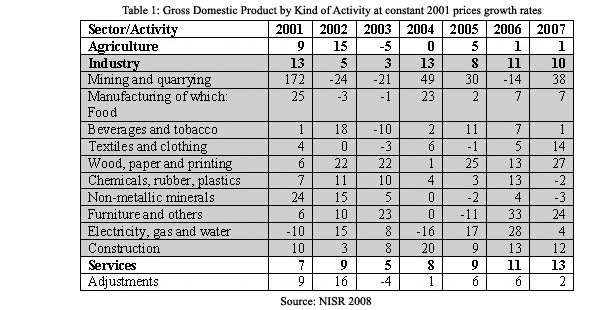
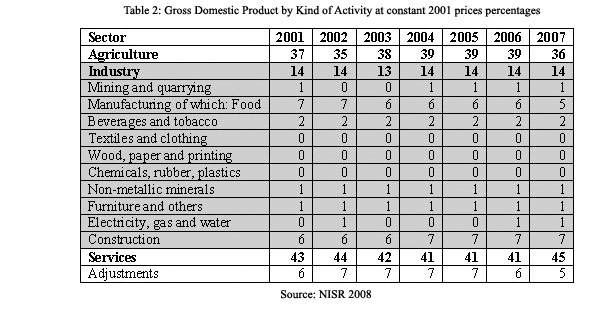
Mining
Mining is an activity that involves excavation of the surface and subsurface for the purpose of exploiting and processing minerals. These minerals are for economic and industrial development in local and foreign markets. Mining is a non-renewable resource activity with great potential. However, although it utilises a small area of the land it can have significant and often irreversible environmental impacts.
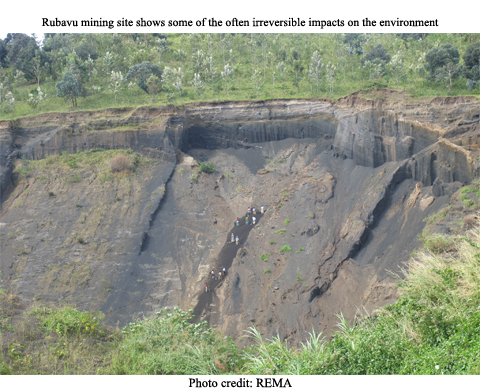
With increasing investments in the mining industry since 2004, there have been proportionate increases in the contribution of the sub-sector to national revenue stream. Mining and quarrying activities expanded by an estimated 55 per cent over 2004, largely boosted by increased cassiterite tin production. Value added in this sector increased from RWF 89 billion in 2003 to RWF 100 billion in 2004. The mining and quarrying sector is estimated to directly employ around 50,000 people in Rwanda. Quarrying has of recent expanded to include other materials such as sand and stones to meet the growing demands of the booming construction industry as well as road construction. Currently, quarry products contribute 11 per cent of the internally generated revenues up from 3-4 per cent of the 1990 levels. Growth in the industrial sector reached nearly 7 per cent over 2004, despite the negative effects of the double energy crisis (rising fuel costs and electricity shortage) and new competitive pressures arising from the COMESA free trade area entry in Jan 2004 (MINECOFIN 2006).
More recently, in the 2006-2007 fiscal year, the mining sector experienced intensive privatization that led to growth. The Mining and Exploration Authority (REDEMI) which has been under government management is currently undergoing privatization with 17 out of a total of 20 concessions already under private ownership. Seven foreign companies have already received permits to conduct research and exploration for gold, nickel, cobalt, platinum, copper and wolfram (PSF 2009). Following the research stage, the companies will formally report results on the reserves prior to being granted concessions for mining. Table 3 illustrates the growing importance of the mining and quarrying activities as contributors to Rwanda’s economic growth.
Mineral revenues were US$ 71 million and 93 million for 2007 and 2008, respectively which have exceeded earlier projected targets. Sector regulations including new data on investors and enhancing value addition in metallic ores are some of the justifications for the overall performance levels in the sector.
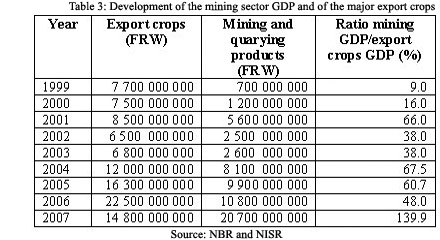
|
Challenges facing the industrial sector
|
Inadequate energy supply
Challenges to rapid industrialization of Rwanda are mainly linked to serious inadequacy of national energy supplies. Electricity has been identified as the biggest challenge to the growth and performance in Rwanda (NSIR 2006). Energy is discussed in greater detail in Chapter 8 on Energy Resources.
Most of the agro-processing industries including tea processing and coffee washing stations, use fuel wood as a source of energy. Rwandans also use a lot of wood for fuel wood. Estimates from 1992, the last year for which figures are available put the amount at 3,510 million kg of wood fuel (Chemonics International Inc 2008). Most of this wood is consumed by homes, though large quantities are also consumed by a variety of commercial users, such as tea factories. This poses issues of land degradation through accelerated erosion with adverse environmental and agricultural productivity impacts. Issues of land degradation are discussed in Chapter 3 on Land use and Agriculture.
Inadequate pollution control
Kigali provides a large proportion of the city’s industrial employment but consequently a larger portion of the urban environmental problems. A significant number of factories which form the industrial base in Kigali are located in a low-lying area called the Gikondo-Nyabugogo wetland. The factories, as well as the densely populated homesteads located on the adjacent hill slopes, have no proper liquid-waste disposal systems, and consequently pollute soils, groundwater and the surface water. Many of the factories use out-dated technologies that are associated with energy demands and waste generation to levels that have adverse impact on the environment, and render the operations expensive and unsustainable. Figure 2 shows a map of the Gikondo valley area.

Industries, petroleum depots and garages have to date been established in unplanned locations which renders pollution control untenable. Lack of planning has resulted in locating industries in the proximity of residential areas which constitute an additional threat to human health and environment. On the other hand, almost all the industries, garages and workshops are located in valleys or marshes bordered by heavily populated areas.
The industrial effluents and by-products are discharged in the water bodies. A number of industries in the Kigali City wetland system include the textile industry, the iron industry which makes iron sheets, paint factories and the Kabuye sugar factory among others. These industries have been responsible for water pollution by the chemical discharges from the industries. The pollutants are for the most part toxic to humans and animals and in some instances and also interfere with the environment by polluting soils. Figure 3 and table 4 show results of water and soil quality samples taken from the Gikondo industrial zone profile stretching from Kicukiro to Nyabugogo.
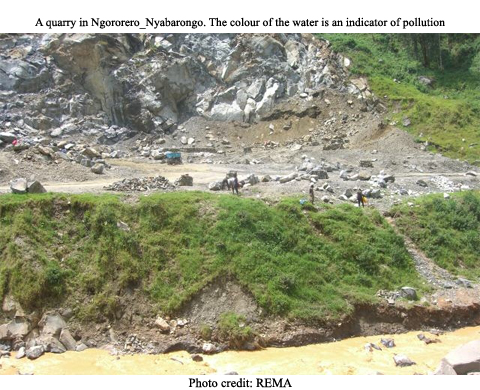
The polluted waters from the industrial park in the Gikondo-Nyabugogo wetland system discharge into the Nyabarongo River and its tributaries. The Nyabarongo feeds into the Akagera River, which flows into Lake Victoria. Thus, the industrial effluents and other pollutants created in the Gikondo-Nyabugogo wetland system pose environmental challenges that extend well beyond the national borders of Rwanda.

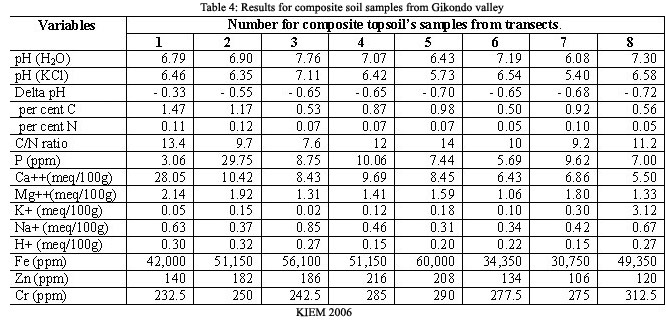
Impacts of mining
Mining activities often impact significantly on the environment. For instance, sand harvesting and quarrying are already shows some significant environmental impacts, including resource depletion, energy consumption, waste generation and emissions of air pollutants. The dangers to human life and health associated with mining include the displacement of people, land use changes, dust and noise pollution.
TIn fact, the preparation of ores which uses a lot of water constitutes a major pollutant of stream water in Rwanda. For example, the waters draining the mining sectors of Rutongo and Gatumba pollute the rivers of Nyabarongo and Nyabugogo by sediments of clay and sand which they transport over long distances. It is this considerable mineral load which partly gives them the brown colour that is characteristic of the rivers in Rwanda. Mining and quarrying produce massive rejects which appear in nature in the form of enormous lots of earth and rocks. Erosion from rain water transports the mineral residue towards the valleys where streams are filled and covered by the residue which may be toxic to biodiversity.
|
Strategies to encourage the development of the industrial sector
|
In order for Rwanda to benefit fully from the privatization policy and encourage more investments, the current aggressive industrialization policy as well as other development directional areas must be clearly integrated with a sustainable environmental management framework.
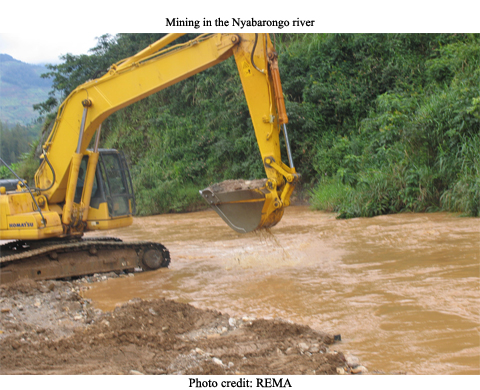
Implementing and mainstreaming environmental legislation
The National Environment Policy of 2003 and Environment Law (No. 4/2005) of 2005 are in place to ensure protection of the ecosystems from degradation and pollution as well as guide rehabilitation of degraded ecosystems. Articles 67 and 68 require all activities likely to have significant environmental impacts to undergo Environmental Impact Assessment (EIA). Effective interventions to pollution from industry and mining will depend on measures such as institutionalization of EIA and Strategic Environmental Assessment (SEA) for policies currently under review such as the small and medium enterprise (SME) policy, the investment policy, the mining policy, and the energy policy.
The mining sector will need to integrate environmental issues the management of mines beyond the adaptation of the EIA process. The institutionalisation of EIAs is a first step towards creating a more environmentally sustainable sector, but for this to be effective the number of initiatives should be followed with the formulation of additional legislation on mine closure, the preparation and implementation of Environmental Action Plans, formulation of environmental standards; and building of capacity for law enforcement.
The new Industrial Policy focuses on five main strategic objectives, namely: enhancement of the performance of the existing manufacturing sector and development of industrial parks and free export zones to facilitate establishment of new industries; development of new product lines; and promoting resource-based manufacturing, among others.
Key environmental interventions in the EDPRS include the rehabilitation of degraded wetlands and other protected areas to ensure the preservation of biological diversity. It is planned to put in place a framework to implement the National Programme for Adaptation on Climate Change (NAPA) and develop a Clean Development Mechanism.
Cleaner production
The Rwanda Cleaner Production Centre has been established and is promoting the cleaner production approach in Rwanda. Box 1 describes cleaner production. Under the Cleaner Production pilot programme, 10 enterprises were participating in the programme and they listed in table 5.
Another module on Cleaner Production was undertaken under the Lake Victoria Environmental Management Project II and primarily targeted training the private sector and touring neighbouring countries to learn from best practices. All these efforts are beneficial towards sustainable industrialization and they will be further augmented by a full project on Cleaner Production once it is implemented through the ministry with the mandate for industrial activities – Ministry of Trade and Industry (MINICOM).
|
Box 1: What is cleaner production?
The cleaner production approach is a preventive, integrated strategy that is applied to the entire production cycle to:
- Increase productivity by ensuring a more efficient use of raw materials, energy and water
- Promote better environmental performance through reduction at source of waste and emissions
- Reduce the environmental impact of products throughout their life cycle by the design of environmentally friendly but cost-effective products.
The net effect is to give enterprises in developing and transition countries a more competitive edge, thereby facilitating their access to international markets.
Source: UNIDO 2009.
|
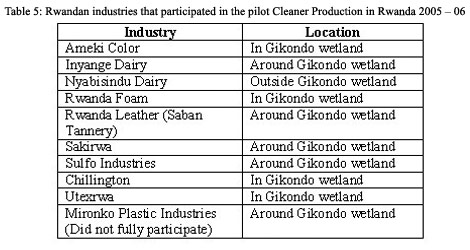
Improving the mining sector
In order for the mining sector to meet its goals within the EDPRS, a number of measures including building domestic mineral extraction and processing capacity; developing a service hub for mineral processing for the sub region and enhancing locally produced construction materials need to be undertaken. These will have the potential to promote private sector participation in exploration, mining and processing, and promote value addition of quarry products to reduce the importing of construction materials.
There are plans to identify potential areas of significant mineral deposits to be mapped by 2012. The new geological surveying programmes conducted by the Geology and Mines Authority (OGMR) will assist in attaining this objective which will provide valuable information to investors. Assisting cooperatives of small miners to acquire knowledge and skills and access appropriate technology will ensure that the mining strategy incorporates a pro-poor component. Programmes will be developed to train women in the skills required by the mining industry. These goals need to be undertaken in the context of good environment management practices. For example at times, mining of gold and more recently colombo-tantalite has led to creation of large mining camps in the forests, some containing more than 3,000 people, with consequent impacts on the environment (Chemonics International Inc. 2008).
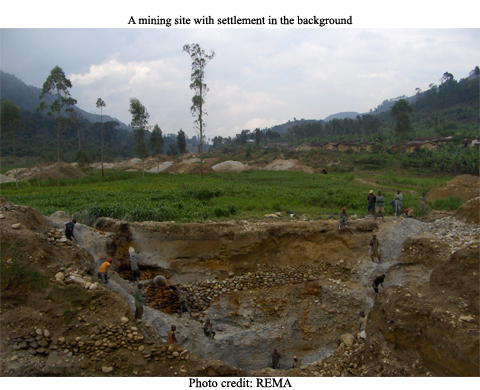
|
Conclusion and recommendations
|
The industry, mining and infrastructure sectors are very important for economic growth and social development. While acknowledging their contribution to the national development, the sectors are associated with varying levels and severity of environmental degradation and major source of pollution. It is therefore critical that the development of these sectors take cognizance of development demands and inputs in a balance with the need for environmental protection in order to ensure that sustainable development is targeted as the ultimate goal. This will be achieved through more efficient production processes and preventive strategies.
Cleaner technologies and procedures can be important mechanisms for reducing impacts on natural resources and the environment.
Compliance with government regulations and policies remains one of the most forceful drivers of environmental performance for most companies, as it requires them to take mandatory actions or meet set standards. Strengthening the efforts for integration of environmental issues in the sector, whether through conducting SEAs, undertaking of EIAs, the use of standards, or other regulatory mechanisms, will certainly contribute to sustainable growth of Rwanda’s economy and move Rwanda closer poverty reduction. Some mitigation measures against the environmental hazards from industry, mining and infrastructure, in support of sustainable economic growth and poverty reduction the sector could, amongst others, do the following:
- Support operationalisation of the existing policy and legal instruments including SEA for policy reviews and EIA for effective project implementation and expedite the development of the tools where they are lacking.
- Reinforce the regulatory environment to guide the private sector in contributing to the financing of environmental management and protection, especially where it concerns preventive actions that mitigate the impact of their development activities.
- Guide the establishment of cleaner production and consumption mechanisms in the sector.
- Facilitate the promotion of the potential of the environmental management within the sector for private investment and Private-Public Partnerships (PPP) development. Areas such as solid waste management, waste water treatment and sanitation offer a lot of opportunities for attracting private investors.
|
References
|
- Chemonics International Inc. (2008). Rwanda Environmental Threats and Opportunities Assessment 2008 Update. EPIQ IQC Contract No. EPP-I-00-03-00014-00, Task Order 02. Biodiversity Analysis and Technical Support for USAID/Africa, USAID, Kigali.
- KIEM (2006). The Social - Economic & Ecological Assessment Report for Gikondo Valley Wetland and Industrial Zone. Technical Appendix. Rwanda Environment Management Authority (REMA), Kigali.
- MINECOFIN (2006). Rwanda and the Brussels Programme of Action. Submission to UN-OHRLLS by the Government of Rwanda for the mid-term review of the implementation of the Programme of Action for the Least Developed Countries. Ministry of Finance and Economic Planning (MINECOFIN), Kigali.
- NISR (2006). The Rwandan Industrial and Mining Survey (RIMS), 2005 Survey Report and Major Findings. Final Report. National Institute of Statistics of Rwanda (NISR), Kigali.
- NISR (2008). Economic Performance As Measured By Gross Domestic Product 2007. National Institute of Statistics of Rwanda (NISR), Kigali.
- PSF (2009). Joint Sector Review 2008. Private Sector Federation (PSF), Kigali
- ROR (2000) Vision 2020. Ministry of Finance and Economic Planning, Republic of Rwanda (ROR), Kigali.
- UNIDO 2009. The CP Concept: What is Cleaner Production? United Nations Industrial Development Organisation (UNIDO). http://www.unido.org/index.php?id=o5151
|
|
|
|